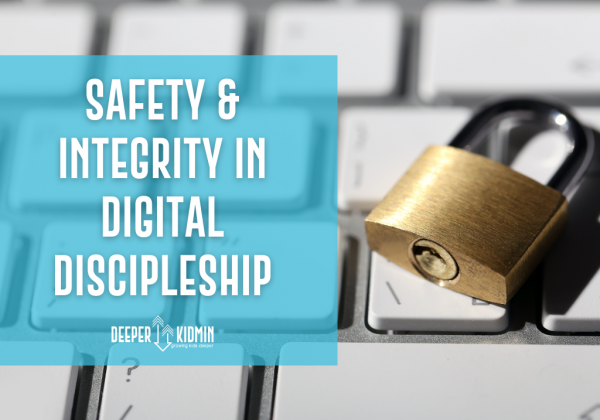
Safety and integrity are vital parts of a healthy children’s ministry, and that applies to our digital ministry strategy too. So how can we keep our kids, families, and volunteers safe while engaging in digital discipleship?
Update your policies and procedures. We have policies for keeping our kids, volunteers, and staff safe in other areas of ministry, and our online presence shouldn’t be any different. This Friday, we’ll share a free children’s ministry social media sample policy template you can use to help you get started plus a few examples from other churches. When thinking about writing your digital/social media policies, think about identifying:
-
-
-
- What is allowed to be shared? (pictures, topics, names, etc.)?
- Who is allowed to share it? (Can volunteers post pictures from Sunday mornings from their personal accounts?)
- When is it allowed to be shared (Before or after an email goes out)?
- How is it allowed to be shared (Through what media or social media platforms)?
-
-
After you’ve crafted your social media policy, be sure to share and communicate this policy with parents, volunteers, staff members, etc. I would recommend making this part of your annual and on-going volunteer training.
Have permission to post pictures of your kids and volunteers – We include a media clause in our annual registration and new kid information forms. Families of course have the option to opt out of this part of the release, but by updating our medical release form to a media and medical release form, we ensured we had written and signed permission to use pictures of kids online. Most families were OK with it, and it helped our team be more aware of any children who could not be in pictures online, especially children in foster care or unique family situations. For volunteers, you can include a media clause within your volunteer handbook or volunteer covenant. Asking permission from your families and volunteers to share pictures of them online shows your respect for them and your diligence to do your part to keep them safe in the digital world.
Don’t share personal information about your kids/families in your posts. This includes names of kids, but also their grade, sports team, neighborhood, school, etc. Even a simple personal post with a caption that says something like, “I so enjoyed watching Haley in the 3rd-grade talent show today at Jackson Elementary!” gives out a lot of personal, potentially harmful, information about that child. I recommend you avoid using a child’s name, age-specific descriptions, or identifying locations (school, neighborhood, etc.). And, if kids are wearing name tags in your pictures from a Sunday morning or another church event, a good rule of thumb is to blur or black out the text on their name tags to help protect them. It takes a little extra work, but it helps you ensure their safety.
Only use content that you have permission to use. This means you should have legal, copyright permission to post all pictures, graphics, images, videos, etc. on your website or social media. I’m not saying you need written permission for every piece of media you share, but be aware of where your pictures are coming from, and give credit if you’re using someone else’s work. I recently found out about a church that was using the graphics from one of my Easter events without permission (meaning they didn’t purchase the resource) and without giving me credit (they – very badly – tried to blur out the Deeper KidMin logo). This is stealing, and it feels very personal to content and graphic creators. You wouldn’t walk into an art store, take a picture of your favorite painting, then print out the picture and frame it for your ministry or claim it as your own artwork. The same mentality applies to digital artwork (and other digital resources) as well. By complying with the licensing and terms of use of any resources (Deeper KidMin or other), you help protect digital intellectual property and help us continue to provide the children’s ministry community with affordable and creative resources. As the church, we have to set the example in sharing content with integrity by making sure we have permission to share it and by giving credit to the original creator. For royalty-free pictures and graphics, I like using Pixabay, Pexels, or Unsplash, and Canva is my go-to place for creating graphics.
Finally, when in doubt, don’t post. If you’re unsure about a post, stay safe, keep your families safe, and don’t hit publish. As leaders, we know “from everyone who has been given much, much will be demanded; and from the one who has been entrusted with much, much more will be asked” (Luke 12:48). We have been entrusted with so much, kidmin leaders, and we are responsible for doing our part to protect those with whom we’ve been entrusted.
P.S. On Friday, we’ll share a children’s ministry social media policy template you can customize and use for your ministry, and you can find our full month’s worth of digital discipleship strategies and resources here.
Want to dive deeper into an intentional strategy for social media in your children’s ministry? Check out our newest online training: The Ultimate Guide to Building a Social Media Strategy for Your KidMin. This online training guides you through creating and sustaining a social media strategy that effectively reaches and disciples the families you serve. Learn more about how to access this training here.


One Comment
[…] of communication require regulation so that they can be more effective and so we can ensure the safety and integrity of our teams and our […]